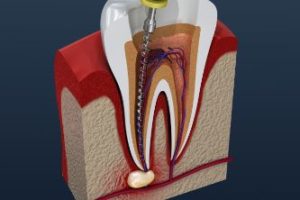 In many ways, it’s easier to fear something you don’t understand than something you do. Root canals are a classic example – many people dread hearing from their dentist that they need a root canal, but they aren’t quite sure why it’s necessary or how the procedure is performed. One thing is certain: The vast majority of patients can’t believe how much easier their root canal is than they expected! Keep reading for a short guide to learn about the symptoms you might notice when you need a root canal and what you can expect from the procedure. You’ll also get some ballpark figures for the cost so there won’t be any surprises!
In many ways, it’s easier to fear something you don’t understand than something you do. Root canals are a classic example – many people dread hearing from their dentist that they need a root canal, but they aren’t quite sure why it’s necessary or how the procedure is performed. One thing is certain: The vast majority of patients can’t believe how much easier their root canal is than they expected! Keep reading for a short guide to learn about the symptoms you might notice when you need a root canal and what you can expect from the procedure. You’ll also get some ballpark figures for the cost so there won’t be any surprises!
What Are the Signs You Might You Notice When You Need a Root Canal?
Every case is unique, but here are some of the symptoms that can indicate the need for a root canal:
- Severe pain or discomfort when you bite down on something
- Prolonged pain or sensitivity to cold or hot temperatures that lingers after the heat or cold has been removed
- Swollen gums or a pimple-like bump on the gums
- Facial swelling on one side
- In some cases, the nerve of the tooth “quietly dies” and there are no symptoms
Why Are Root Canals Necessary?
Before explaining why root canals are necessary, it’s helpful to give a brief anatomy of a tooth first. All teeth have three layers: the outer layer is called enamel, the middle layer is called dentin, and the innermost layer is the pulp or nerve canal.
Any time you have a damaged tooth, whether it’s a cavity, fracture or other injury, a dentist will determine how much of each layer is affected. When the damage is small, the pulp and nerve of the tooth are still intact and most of the tooth structure still remains. In these cases, a filling or crown can restore the tooth.
But if the damage is large enough, it can reach the nerve of the tooth and cause an infection and severe pain. In this scenario, a root canal is needed to remove the infected pulp, while saving the remaining outer layers of the tooth.
What Is the Procedure Like?
You’ll be glad to know that the first step is making sure you’re completely numb and comfortable! Then:
- A small opening will be made in the top of your tooth to remove the infected tissue
- The canals will be thoroughly cleaned and flushed out
- The canals will then be filled with a rubbery material called gutta-percha
- Finally, the tooth will be sealed over with a tooth-colored filling material
As for cost, there are many factors that must be taken into account, but a good ballpark figure is $900-$1,100. Many insurance plans will cover between 50% -90%. Also, since a root canal removes a tooth’s blood supply and causes it to become brittle, a dental crown is usually recommended to restore the tooth’s strength.
While root canals have a bad reputation, they’re actually a wonderful procedure for getting you out of pain and saving your teeth. And they’re much easier than you would expect!
About the Author
Dr. Bernard Florento is a general, cosmetic and restorative dentist with almost 30 years of experience who knows the value of saving teeth whenever possible. He combines his experience and advanced training with a warm, reassuring chairside manner to make root canals comfortable for his patients. If you have any questions, he can be contacted through his website or at (602) 483-4055.
